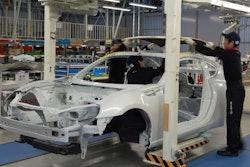Forward-thinking organizations across industries are seizing opportunities to adopt new technologies to enable digital transformation and improve business operations, but the construction industry has been notably slower in adopting digital technologies compared with other industries.
In its 2016 construction technology report, JBKnowledge, a Texas-based IT consulting firm, notes that despite the proliferation and improvement of technology, companies in the building trades still only allocate a minimal amount of budget for it. The report goes on to say that 70 percent of construction companies spend less than 1 percent of annual sales on IT, a figure that increased 25 percentage points year-over-year.
Those are concerning stats, given that the construction and building industries, while gaining more digital traction in adopting such tools as 3D printing and drones, rely so heavily on timely documentation and require just as much — if not more — data management, transfer, and integration technology as any other industry.
But it’s not just about budget. Organizations are finding creative ways to pay for technology investments, including bankrolling IT as part of their operational expenditure (instead of its capital expenditure) budgets and leveraging more subscription models. It’s also about understanding the strategy of integrating new and existing technologies to drive business gains.
The fact is, global businesses are becoming increasingly connected via digital economies and ecosystems. Your business partners and even your competitors exist all over the planet, and technology must become the unifying factor. Because when technology is leveraged as part of an overarching information integration strategy, it also becomes your competitive differentiator.
Sure, the Internet of Things eventually will bring factors of efficiency to the construction industry, but that promise is years away from fulfillment. Today’s differentiation and competitive advantage, though, will come from supply chain optimization.
To truly deliver a competitive advantage, construction-related companies must embrace an information integration strategy that streamlines data flows and improves supply chain processes.
What to Look For
The construction industry relies so heavily on data communications to ship and build all over the world that any organization without the proper visibility into those supply chains is exposing itself to non-compliance sanctions and chargebacks, and is increasing its risk of revenue loss.
To thrive today, companies must embrace proven electronic data interchange (EDI), the international language of e-commerce. Processes that include inventory checks, quotes, purchase orders, remittance, and tracking and logistics must take place in a well-governed, consistent, and dependable way, and EDI delivers that in a way other less flexible syntaxes cannot.
But a fully-aligned data strategy includes more than just EDI. It’s augmented with technology that easily connects with other applications, transforms documents to partner specifications, and supports real-time and batch integration to deliver the utmost flexibility.
Additionally, exchanging information like blueprints, CAD renderings, building permits and inspections, appraisals, water and soil analyses and site photos and videos with engineers, government agencies, contractors and other stakeholders requires flexible platforms with acceleration technologies that can move gigabytes efficiently.
Thus, it’s the organizations that deploy agile managed file transfer (MFT) and B2B integration solutions to modernize EDI processes, integrate internal ERP systems, expedite file transfers and interface with cloud APIs that are optimizing their global supply chains and creating real value for their customers.
How to Get Ahead
The good news is that businesses don’t necessarily have to start from scratch to integrate their digital workflows. The savviest manufacturers, distributors, and other construction and building firms leverage existing IT investments and look for ways to integrate other components of their ecosystems.
A modern, single-platform integration solution leverages all your technologies to deliver:
- EDI automation: Eliminate manual workflows, mitigate human error and build stronger communications and relationships with trading partners
- Business-friendly dashboards: View end-to-end data transactions to gain a holistic view of the document life cycle and proactively address challenges
- Application and cloud integration: Connect the data flows among a back-end ERP system, cloud-based design software or CRMs and external information exchanges for seamless data handoff
- Ad-hoc file sharing: Support a global workforce, including remote contractors and on-site job crews, with secure document sharing via mobile devices
Improving data exchange and collaboration between vendors, suppliers, logistics organizations and customers results in improved efficiency, better visibility within the supply chain and faster time to revenue, which can deliver a tremendous advantage for organizations competing for a piece of the global construction pie.
Grabber Construction Products, a distributor of construction products, embraced the evolution of technology in the building materials industry and committed to improving the company’s infrastructure.
“There’s real opportunity for better data exchange and collaboration among trading partners in the construction industry, and it’s definitely affected how we do business,” said Kory Lewis, IT manager at Grabber. “Investing in integration technology helped us improve our EDI workflows, especially with invoicing, and has led to sustainable business value for the company.”
The construction industry is poised to unlock faster data exchange, expanded systems integration, improved visibility and easier collaboration, but it won’t happen without investing in and committing to an information integration strategy upfront.
Mahesh Rajasekharan is the CEO of Cleo.























